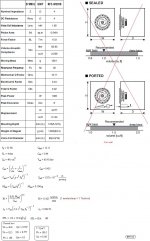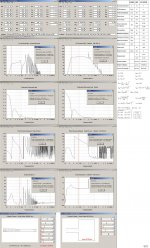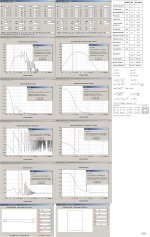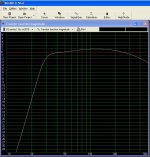Hi guys,
I have a kenwood kfc w3010.I would like to design an enclosure.I have a few questions:
*Where is the boundary in terms of volume between tight bass and deep bass?
I like deep but not boomy.
*Stuffing material would be a layer of blanket,how would this affect the perceived volume?
I would like to go sealed though it compromises efficiency,but then the driver is quite efficient at 93 db/w/m.
What do you think?How large will a ported one need to be to go down to 25 Hz?
Regards.
I have a kenwood kfc w3010.I would like to design an enclosure.I have a few questions:
*Where is the boundary in terms of volume between tight bass and deep bass?
I like deep but not boomy.
*Stuffing material would be a layer of blanket,how would this affect the perceived volume?
I would like to go sealed though it compromises efficiency,but then the driver is quite efficient at 93 db/w/m.
What do you think?How large will a ported one need to be to go down to 25 Hz?
Regards.
A ~flat response in-room is required, so it's a function of the room's Q summed with the cab's Q, ergo there's no set volume that defines it. A speaker setting on a large parking lot (half space loading) OTOH will need a Qtc (sealed) or Qtb (vented) = 0.707 or what's commonly referred to as a T/S max flat alignment.
From this we see that a < 0.707 Qt alignment is usually required in-room to keep it from sounding 'boomy'.
What are the driver's specs?
GM
From this we see that a < 0.707 Qt alignment is usually required in-room to keep it from sounding 'boomy'.
What are the driver's specs?
GM
A ~flat response in-room is required, so it's a function of the room's Q summed with the cab's Q, ergo there's no set volume that defines it. A speaker setting on a large parking lot (half space loading) OTOH will need a Qtc (sealed) or Qtb (vented) = 0.707 or what's commonly referred to as a T/S max flat alignment.
From this we see that a < 0.707 Qt alignment is usually required in-room to keep it from sounding 'boomy'.
What are the driver's specs?
GM
Filling in...😀
b🙂
Attachments
Filling in...
Thanks! As fate would have it, I Googled for it right after posting and found it immediately, but got sidetracked and all I got done was loading it into WinISD Pro which returned an 80.8 L net/28 Hz vented alignment with a 200 W peak handling to Fb. Even at this relatively low power it still needs dual 4" vents > 27" long, so as you know, some form of larger TL loading is required to make this driver 'sing'.
GM
Thanks!I just installed WinISD Pro.I loaded the values but i seem to get totally different results.I've never used it before but i went through a tutorial step by step.
Let me describe it just after hitting the 'finish' button before any changes:
*80.35 litres
*Tuning freq 29.90 Hz
*4" dia 26.57 cm long port
*frequency response -3.033dB at 27.70 hz
0.006dB at 46.39 hz and peaks at 119.49 hz at 0.968dB before dropping.
I hope you get the picture.
My other concern is about the sensitivity,according to WinISD its 88.81dB/W/M but according to the datasheet its 93dB.Which is the real value?I thought sensitivity is a measured value rather than a calculated value?
How does a frequency response of boomy box look like?How about a 'tight bass' one?
What do you mean by 'TL loading'?
Regards.
Let me describe it just after hitting the 'finish' button before any changes:
*80.35 litres
*Tuning freq 29.90 Hz
*4" dia 26.57 cm long port
*frequency response -3.033dB at 27.70 hz
0.006dB at 46.39 hz and peaks at 119.49 hz at 0.968dB before dropping.
I hope you get the picture.
My other concern is about the sensitivity,according to WinISD its 88.81dB/W/M but according to the datasheet its 93dB.Which is the real value?I thought sensitivity is a measured value rather than a calculated value?
How does a frequency response of boomy box look like?How about a 'tight bass' one?
What do you mean by 'TL loading'?
Regards.
You're welcome!
The program returned an audibly insignificant alignment to mine, so at a glance it's a potentially viable design once damped. It chose too small a vent though due to it assuming a 1 W input, so in the SIGNAL tab, input 200 in the SYSTEM INPUT POWER window and check its REAR PORT-AIR VELOCITY plot with the understanding that you want it to be < ~17 m/s (and preferably lower) to keep it from audibly compressing and adjust the vent number/size as required to get predicted vent length. Note that it's a good plan to have all dims the same to avoid confusion (in, cm, etc.).
Its calculated sensitivity is a realistic one to design based on whereas a manufacturer's published measured one is often either a high inductance peak or break-up mode well above its intended pass-band, i.e. the audio industry's equivalent to the vehicle marketing horsepower 'race' of the '60s. Just like back then, 'when the flag drops, the B_S stops', so BW limit the driver to its nominally flat pass-band and its measured sensitivity in half space should be very close (if not spot on) to its calculated one.
'Boomy' (under-damped)/'tight' (over-damped) sounding in-room can be caused in various ways and more than likely the one you posted will sound 'boomy' in a typical HIFI/HT app if not damped even though it would be relatively 'tight' outdoors, but the obvious is to just either tune what you have a few Hz higher/lower to see this and why fine tuning a vented alignment in-room is so critical to overall good performance.
Transmission Line (TL) alignments encompass all 1/4 WL resonant pipe/horn layouts that don't have a well defined vent, so must be fine tuned with damping material for wide BW performance above its 3rd harmonic two octaves above its tuning (Fp), i.e. a 20 Hz Fp has a ~80 Hz 3rd harmonic dip and 'rippled' response above it.
Historically, an optimum TL alignment is stuffed until the driver's Fs impedance peak is ~completely flattened, ie. aperiodically loaded to present a ~matching impedance (DF = 1) to the low/power high output impedance amps of the day. Properly designed, it also flattens out the rest of the driver's response in its pass-band, so includes any mid bass hump in the response due to an excessively high voice coil (VC) inductance.
With the advent of ever increasing higher power and lower output impedance amps though, these alignments for the most part went the way of the Dodo bird and has only had a resurgence since MJK published his findings some years ago, then offering MathCad software to accurately design them and their mass loaded (vented) variants (MLTL, etc.).
Specifically to my remark though, today's mainstream drivers are designed to work in very acoustically small box volumes (Vb) with the trade-off being lower efficiency, so obviously more power is required to reach a given SPL which in turn means a larger, longer vent to keep vent compression low. At some point then, the vent becomes big enough in bulk that one might as well morph it with the box Vb to create a reverse tapered horn (TQWT) to increase loading/damping for a given bulk.
GM
The program returned an audibly insignificant alignment to mine, so at a glance it's a potentially viable design once damped. It chose too small a vent though due to it assuming a 1 W input, so in the SIGNAL tab, input 200 in the SYSTEM INPUT POWER window and check its REAR PORT-AIR VELOCITY plot with the understanding that you want it to be < ~17 m/s (and preferably lower) to keep it from audibly compressing and adjust the vent number/size as required to get predicted vent length. Note that it's a good plan to have all dims the same to avoid confusion (in, cm, etc.).
Its calculated sensitivity is a realistic one to design based on whereas a manufacturer's published measured one is often either a high inductance peak or break-up mode well above its intended pass-band, i.e. the audio industry's equivalent to the vehicle marketing horsepower 'race' of the '60s. Just like back then, 'when the flag drops, the B_S stops', so BW limit the driver to its nominally flat pass-band and its measured sensitivity in half space should be very close (if not spot on) to its calculated one.
'Boomy' (under-damped)/'tight' (over-damped) sounding in-room can be caused in various ways and more than likely the one you posted will sound 'boomy' in a typical HIFI/HT app if not damped even though it would be relatively 'tight' outdoors, but the obvious is to just either tune what you have a few Hz higher/lower to see this and why fine tuning a vented alignment in-room is so critical to overall good performance.
Transmission Line (TL) alignments encompass all 1/4 WL resonant pipe/horn layouts that don't have a well defined vent, so must be fine tuned with damping material for wide BW performance above its 3rd harmonic two octaves above its tuning (Fp), i.e. a 20 Hz Fp has a ~80 Hz 3rd harmonic dip and 'rippled' response above it.
Historically, an optimum TL alignment is stuffed until the driver's Fs impedance peak is ~completely flattened, ie. aperiodically loaded to present a ~matching impedance (DF = 1) to the low/power high output impedance amps of the day. Properly designed, it also flattens out the rest of the driver's response in its pass-band, so includes any mid bass hump in the response due to an excessively high voice coil (VC) inductance.
With the advent of ever increasing higher power and lower output impedance amps though, these alignments for the most part went the way of the Dodo bird and has only had a resurgence since MJK published his findings some years ago, then offering MathCad software to accurately design them and their mass loaded (vented) variants (MLTL, etc.).
Specifically to my remark though, today's mainstream drivers are designed to work in very acoustically small box volumes (Vb) with the trade-off being lower efficiency, so obviously more power is required to reach a given SPL which in turn means a larger, longer vent to keep vent compression low. At some point then, the vent becomes big enough in bulk that one might as well morph it with the box Vb to create a reverse tapered horn (TQWT) to increase loading/damping for a given bulk.
GM
Hi guys
sorry i haven't replied,i've been busy with class work.
Anyway,i thought of updating you guys of the development. I ended up with a 99 litre box with a 4" inch diameter port tuned to 29hz. It sounds decent with a 40 watt amp,but the bass is not that deep as i expected.
I have another question:i've read about woofer break in,is it a fact? I already have a sine wave generator. How do i go about it?
Regards.
sorry i haven't replied,i've been busy with class work.
Anyway,i thought of updating you guys of the development. I ended up with a 99 litre box with a 4" inch diameter port tuned to 29hz. It sounds decent with a 40 watt amp,but the bass is not that deep as i expected.
I have another question:i've read about woofer break in,is it a fact? I already have a sine wave generator. How do i go about it?
Regards.
Hi guys
sorry i haven't replied,i've been busy with class work.
Anyway,i thought of updating you guys of the development. I ended up with a 99 litre box with a 4" inch diameter port tuned to 29hz. It sounds decent with a 40 watt amp,but the bass is not that deep as i expected.
I have another question:i've read about woofer break in,is it a fact? I already have a sine wave generator. How do i go about it?
Regards.
I've yet to see any convincing data that supports "woofer break in". My own measurements do not support it.
I take it you used the published specs of your woofer. The actual specs might be quite different. Know anyone with a WT3? 🙂.
About your own measurements,did you use WT3 before and after 'break in'?How long did it take?(i need as much info as possible to show that there's no such thing as break in).
I used the published parameters.Where i come from,people don't know about enclosure tuning!I myself didn't know about WT3,until you replied!
The enclosure is not that bad,considering that the carpenter charged me 5$! There is no stuffing and no rattling.I am still looking for an amp,a 100w one will do in such a small room.
I read somewhere that stuffing an enclosure increases the perceived volume by 20%,how will the sound change if i stuff this box?
Regards.
I used the published parameters.Where i come from,people don't know about enclosure tuning!I myself didn't know about WT3,until you replied!
The enclosure is not that bad,considering that the carpenter charged me 5$! There is no stuffing and no rattling.I am still looking for an amp,a 100w one will do in such a small room.
I read somewhere that stuffing an enclosure increases the perceived volume by 20%,how will the sound change if i stuff this box?
Regards.
- Status
- Not open for further replies.
- Home
- Loudspeakers
- Subwoofers
- 12" driver enclosure size



